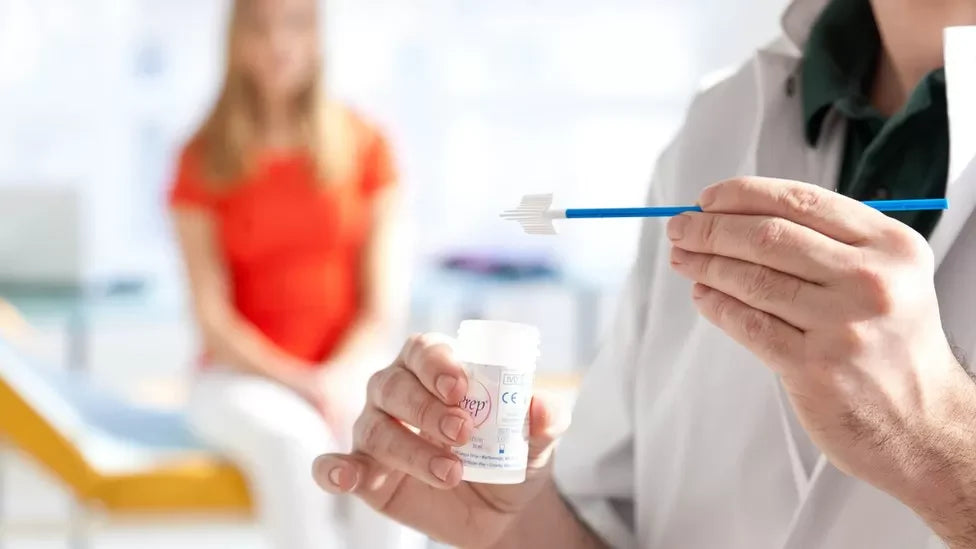Everything You Need to Know Before Your First Pap Smear Test

Going for your first pap smear test (also known as a smear test or cervical screening test) can feel a bit intimidating if you don’t know what to expect. But knowing why it's important, how to prepare, and what the results mean can help you feel more confident and relaxed.
This blog post will walk you through everything you need to know before going for your first cervical screening test, including what it is, when to get one, why it’s best not to go during your period, and what the different kinds of results mean.
What is a Pap Smear Test?
A pap smear is a simple medical test that checks for abnormal changes in the cells of your cervix (the lower part of your uterus). These changes can sometimes lead to cervical cancer if left untreated. The main purpose of a cervical screening test is to catch any cell changes early before they have a chance to develop into something more serious.
In the UK, most women are invited to have their first smear test around the age of 25, and then every 3 to 5 years after that. It’s a quick, routine procedure that can help prevent cervical cancer, which is why it’s so important to stay on top of your screening schedule.
If you're looking for more detailed information, the NHS cervical screening page provides a thorough explanation of why screening is done and how it works.
When Would You Have a Smear Test?
In the UK, the NHS sends out invitations to women and people with a cervix starting from the age of 25. These are routine checks and part of a preventive health programme.
Here’s when you’ll typically be invited for a pap smear test:
- Ages 25-49: Every 3 years.
- Ages 50-64: Every 5 years.
- Ages 65 and older: Only if one of your last 3 tests had abnormal results.
If you’re over 25 and haven’t received your invitation yet, or if you’ve missed a previous test, you can contact your GP to book an appointment. You can also opt for a private smear test if you prefer to go through private healthcare providers.
Some women may need more frequent testing, especially if they have a history of abnormal results. If you're unsure when you should have your test, visit the NHS cervical screening guidelines to check your eligibility and screening frequency.
Preparing for Your Smear Test
While a pap smear is a quick and simple test, there are a few things you can do to make the experience easier.
Avoid Your Period
It’s important not to book your smear test during your period. Having the test while you’re menstruating can make it harder for the nurse or doctor to get a clear sample of cells from your cervix. This might mean you’ll need to come back for a repeat test. Ideally, try to schedule your test for the middle of your cycle, about 7-14 days after your period starts.
What to Wear
Wear something comfortable and easy to remove from the waist down. Some people prefer wearing a skirt or a dress since you’ll only need to lift it up, rather than fully undressing. This can help you feel a bit more comfortable during the test.
Stay Calm and Relax
It’s normal to feel nervous, but remember that this is a routine test done by healthcare professionals all the time. Try to stay relaxed during the test – taking deep breaths can help. If you're feeling particularly anxious, let your nurse or doctor know. They’re there to support you.
Avoid Vaginal Products
In the 24 hours before your test, avoid using tampons, vaginal creams, gels, or douches. These products can interfere with the accuracy of the test by washing away or covering up cells that need to be tested.
What Happens During the Pap Smear Test?
The actual test only takes a few minutes, and the nurse or doctor will explain everything as they go.
Here’s what to expect:
Undressing
You’ll be asked to undress from the waist down and lie on an examination table with your knees bent and feet apart. You’ll usually be given a paper sheet to cover yourself.
Inserting the Speculum
The healthcare provider will gently insert a speculum (a small, smooth plastic or metal tool) into your vagina. This might feel a little uncomfortable, but it shouldn’t hurt. The speculum helps to open the vaginal walls so that the cervix can be easily seen.
Taking the Sample
Using a soft brush or spatula, the nurse or doctor will gently collect some cells from the surface of your cervix. This part might feel a bit like a light scratch but should only take a few seconds.
Removing the Speculum
Once the sample is taken, the speculum is gently removed, and the test is complete!
That’s it – your cervical screening test is done! You’ll be able to get dressed and continue with your day as usual. The sample will be sent to a lab for analysis, and you’ll receive your results in a few weeks.
Why You Shouldn't Get a Pap Smear During Your Period
It’s recommended to avoid having a pap smear while you're on your period, and here’s why:
- Less Accurate Results: Menstrual blood can make it harder for the lab to get a clear view of the cells collected, leading to the possibility of inconclusive results.
- Needing a Retest: If your results come back unclear due to blood or mucus, you might have to return for a retest, which could mean more waiting and extra stress.
To avoid this, try to schedule your smear test for a time when you’re not on your period. Mid-cycle is typically the best time, but you can always ask your GP or nurse for advice on timing.
Understanding Pap Smear Test Results
After your cervical screening test, you’ll receive your results by letter, usually within 2 to 6 weeks. The results will show whether the cells from your cervix are normal or if there are any changes that need further attention.
Here’s a quick guide to the possible results:
Normal Results
No abnormal cells were found, and you won’t need another test for 3-5 years (depending on your age)
Inconclusive Results
Sometimes, the results may be unclear. This could be due to an insufficient sample or the presence of blood or mucus. In this case, you’ll be asked to come in for a repeat test.
Abnormal Results
If abnormal cells are found, don’t panic. Abnormal results don’t necessarily mean you have cervical cancer. In most cases, the abnormal cells are due to a condition called cervical dysplasia, which means there are changes in your cells that could, over time, lead to cancer if left untreated.
If your test detects HPV (human papillomavirus), a follow-up test may be recommended. HPV is a common virus that can cause changes in cervical cells.
Further Testing
If you receive an abnormal result, you may need to go for a follow-up test called a colposcopy, where a closer examination of your cervix is performed.
For more information about pap smear results, visit the NHS cervical screening results page.
Private Smear Tests: Are They an Option?
While the NHS provides free smear tests every few years, some women prefer to go through private healthcare providers. This may be an option if you want more frequent testing or need additional reassurance. A private smear test is usually similar to the NHS test but may offer faster results or additional services like HPV testing.
Getting your first pap smear test can feel a little nerve-wracking, but it’s an important part of taking care of your health. Knowing what to expect and how to prepare will make the process much easier. Remember, cervical screening saves lives by detecting changes early – so don't put off your test.



